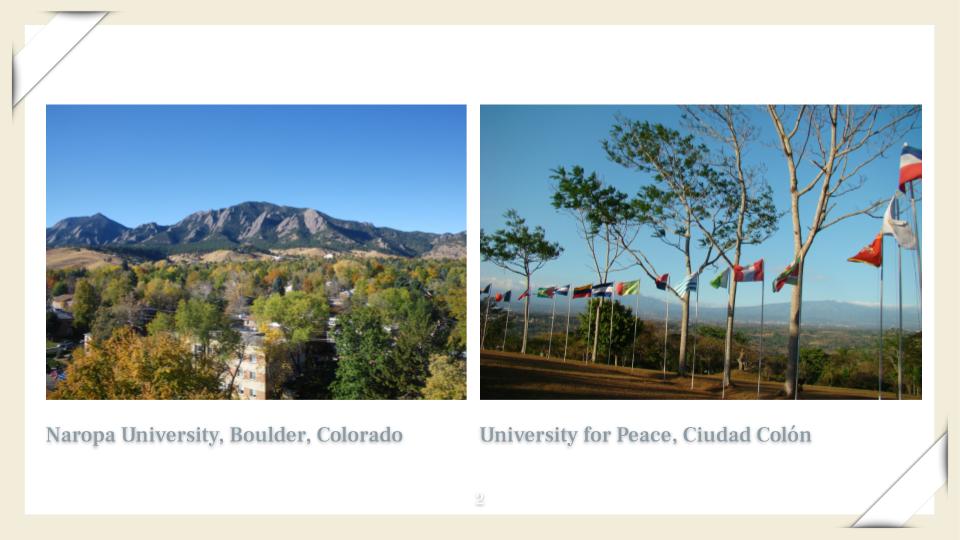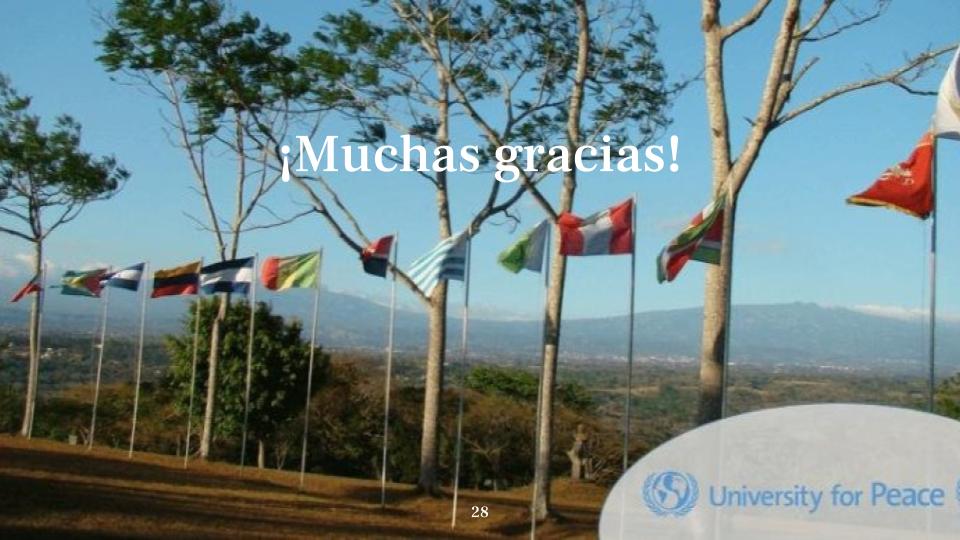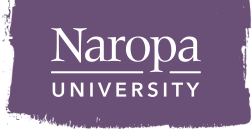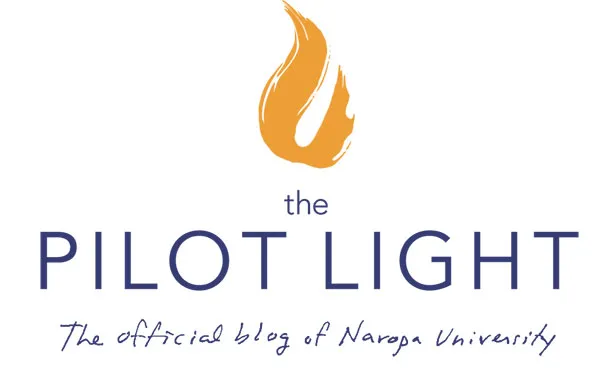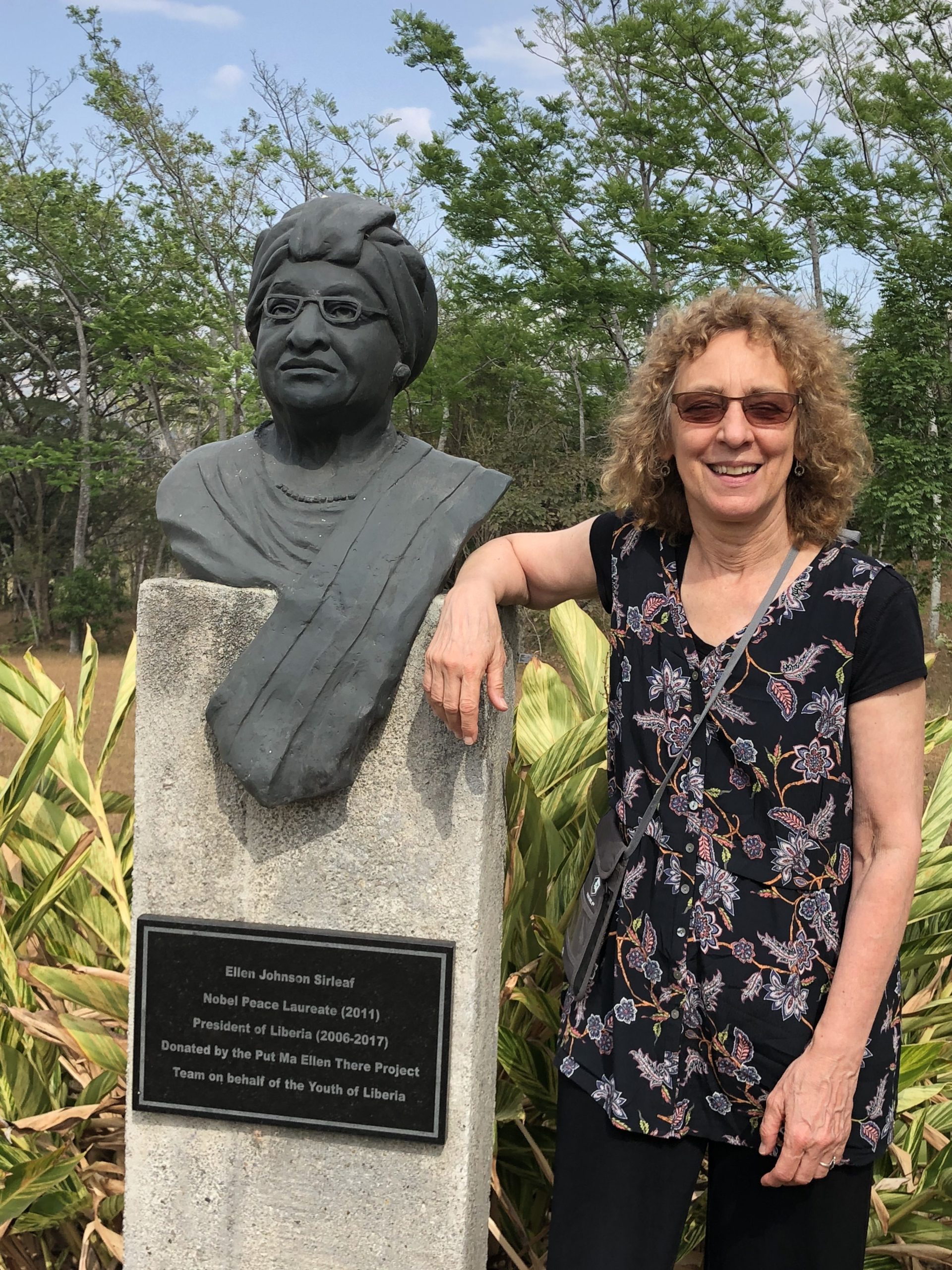
By Candace Walworth, Professor of Peace Studies & Interdisciplinary Studies at Naropa University
“Peace cultures thrive on and are nourished by visions of how things might be, in a world where sharing and caring are part of the accepted lifeways for everyone.” —Elise Boulding
As a professor of Peace Studies, I’ve long been fascinated by Costa Rica, a country that abolished its military in 1948 and is home to the University for Peace (UPEACE). In February, as part of my 2018-19 sabbatical, I visited both the country and the university, where I presented “Narrative Power for Social Change: Digital and Civic Media Storytelling,” a workshop built upon on my sabbatical research and years of incorporating digital storytelling and civic media storytelling projects into my courses. While the presentation was the impetus of my visit to UPEACE, the connections I made there spoke to larger themes of informal and formal peace education, environmental protection, and the potency of cross-cultural conversation and collaboration.
The University for Peace, located in the Central Valley of Costa Rica, is home to approximately 175 students from 50 countries. Six years younger than Naropa University, UPEACE was established in 1980 through an agreement adopted by the General Assembly of the United Nations “to provide humanity an international institution of higher education for peace.” Costa Rica’s 1948 military abolition, which shifted war and defense spending to education and healthcare, set this Central American republic up as an ideal country to host a multicultural student and faculty body committed to interdisciplinary peace research, innovation, and action.
I have known about UPEACE for more than a decade, even recommending it to Naropa alums interested in pursuing advanced degrees in Peace and Conflict Studies, Environment and Development, International Law, or Peace, Conflict, and Media Studies. However, February was my first visit to its campus. Christopher Santee, a Naropa alum and one of two student initiators of Naropa’s Peace Studies program, put me in touch with Dr. Heather Kertyzia, Chair of UPEACE’S Department of Peace and Conflict Studies, and Ross Ryan, Coordinator of the M.A. in Media and Peace, who hosted and facilitated my visit.
After dwelling in northwestern Costa Rica near the Arenal volcano, Professor Emerita Lee Worley and I traveled to the Monteverde region, home of the famous cloud forests, where we hoped to—dreamed of—catching a glimpse of the Resplendent Quetzal, a bird that feeds on wild avocadoes in the cloud forests, but who is elusive to humans. Rounding the bend of a trail in the Monteverde Cloud Forest, we were stunned by the appearance of a pair of Quetzals, lounging in the tree-tops, allowing us time to settle in, attune, and breathe in their presence. The filtered sun illuminated the birds’ crimson chests, their green and blue wing feathers and striking train of a tail. I felt a deep sense of welcome, at home as a human in an awesome family-of-life.
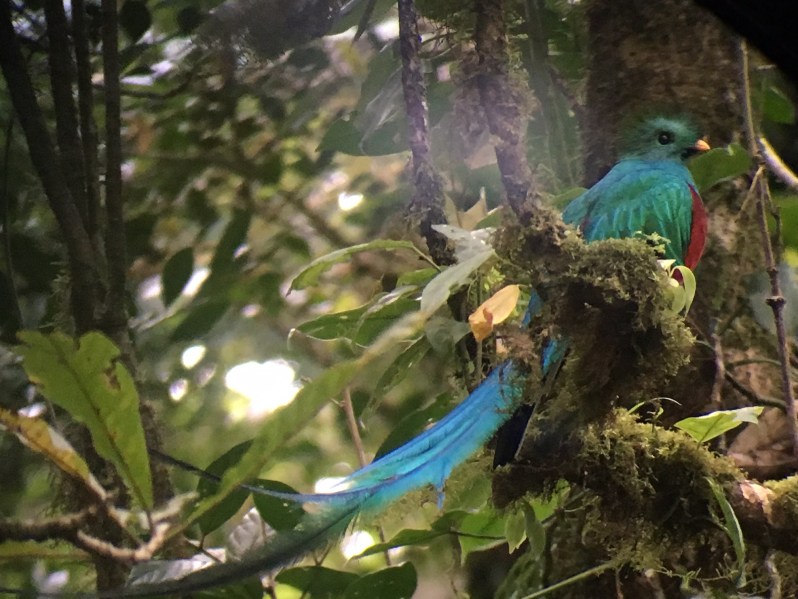
The next morning, just a few miles away as the crow flies, came another opportunity to settle in and attune, this time in the built environment: the silence and vocal ministry (in Spanish and English) at a Monteverde Friends (Quaker) meeting. The Monteverde Meeting has its origins in 1950, when, disheartened by the United States’ increasing military spending and inspired by Costa Rica’s abolition of its army, eleven Quaker families immigrated to Costa Rica. In addition to practicing its core values of simplicity, peace, integrity, equality, community, and care for the environment, the Monteverde Friends School and the Montverde Friends Meeting have been instrumental in local and regional conservation efforts.
After exploring Costa Rica’s Pacific coast from Manuel Antonio to the Osa Peninsula, I headed to the Central Valley for my presentation. UPEACE’s main campus (Campus Rodrigo Carazo) also houses the Center for Executive Education, the Earth Charter Center for Education for Sustainable Development, a nature preserve that includes the last stand of primary forest in Costa Rica’s Central Valley, a student-run garden, a public restaurant and peace garden, and a classroom for community outreach and adult education.
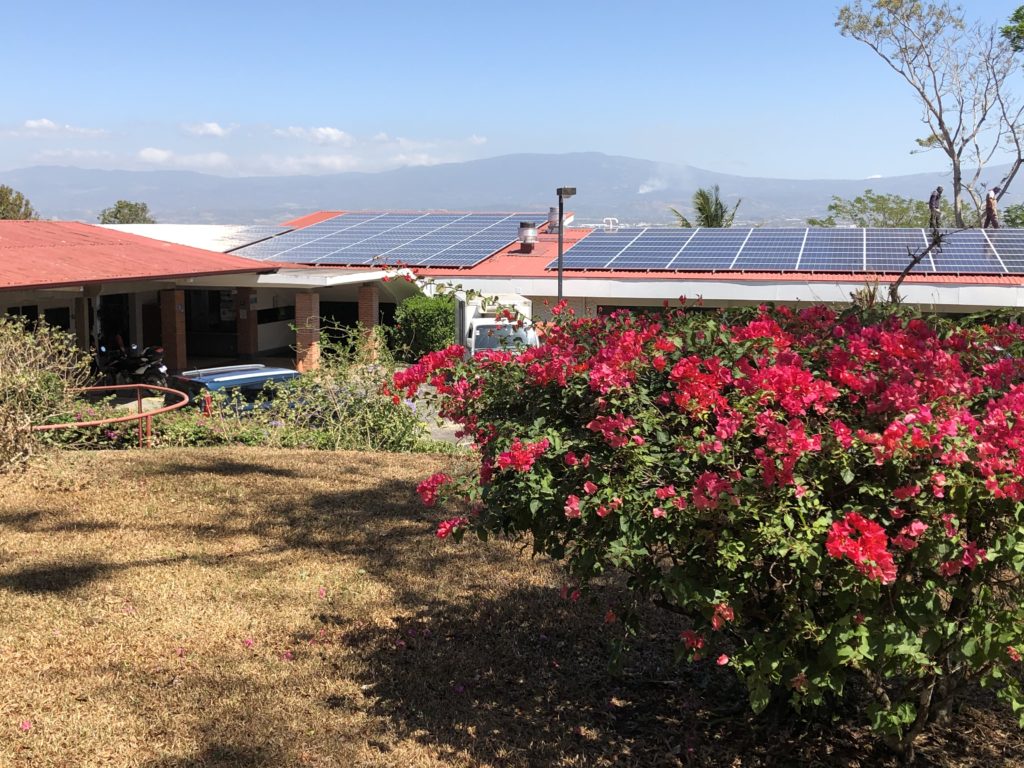
Before my noon workshop, I visited the university library. There I came upon a book display on strategic nonviolence. I was delighted to see Boulder Quaker Elise Boulding’s Cultures of Peace: The Hidden Side of History (2000), especially since I’d just attended the Montverde Friends Meeting.
Working as a woman in a male-dominated field, Boulding (1920-2010) was a futurist, feminist, peace researcher and activist who taught Sociology at the University of Colorado and was a Naropa commencement speaker during John Cobb’s presidency. Considered one of the founding mothers of the interdisciplinary field of Peace Studies, her holistic view of peace education has inspired and informed approaches and methods now baked into Naropa’s Peace Studies curricula.
While mainstream media often focuses on the symptoms of violence, Boulding helped catalyze a paradigm shift by urging peace researchers and practitioners to illuminate the presence of cultures of peace. Boulding referred to the family as the “practice ground for making history” and to children as peace actors and animators, requiring the most creative, compassionate and highly skilled educators that communities—locally to globally—can muster.
As I left the library to set up for my presentation, I felt buoyed by the spirit of Elise Boulding and her lifelong work to translate a vision of global citizenship into action.
Approximately 25 members of the UPEACE community attended my presentation, held in a classroom that doubles as a boardroom for UPEACE trustees. The boardroom, more formal than other UPEACE classrooms, featured a podium at the front of the room, flanked by a photographic mural of peacebuilders from around the world, including Nobel Peace laureates Shirin Ebadi and Malala Yousafza. Again, I was in good company. As students arrived and found their seats, it occurred to me that with the exception of the fact that students were conversing in multiple languages, this could have been a graduate classroom at Naropa. As English is one of the common languages at UPEACE, we began the workshop—in English.
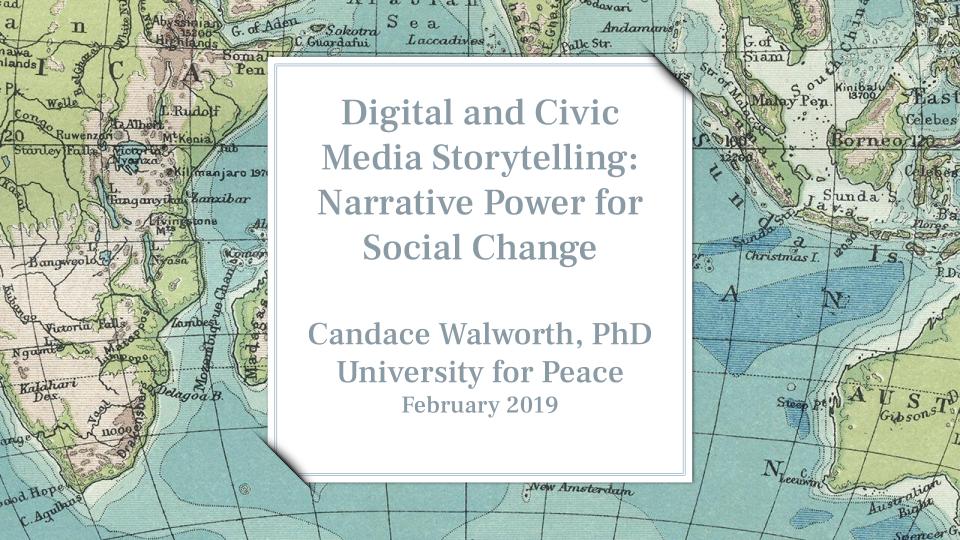
My goal was to engage the UPEACE community in a conversation about the role of civic media storytelling—from tweets to YouTube to podcasts to digital stories to TED talks—in fostering social impact. I chose to focus on climate justice storytelling, in part because of Costa Rica’s commitment to sustainable development and its National Decarbonization Plan, and because I wanted to learn more about UPEACE and Costa Rican climate justice storytellers: Who are they, and what kinds of narratives are they creating to help inform and build an activated public?
To connect UPEACE and Naropa students, I began with a digital story “Collision,” written and produced by Daniel Jubelirer (Peace Studies, 2017) in a Naropa Peace Studies class. Without giving too much away, the story revolves around the death of Daniel’s grandfather, a bike accident, and the decision to leave an elite university. It raises questions about speed, urgency, disappointment, despair, and how to re-imagine the American Dream. What did his grandfather—the generation of Jewish Americans who fought in World War II—mean by ‘the good life’ and what does it mean to his millennial generation grandson?
Next, I turned to Costa Rican Monica Araya’s 2016 TED talk, “A Small Country with Big Ideas to Get Rid of Fossil Fuels.” Like Daniel, Dr. Araya takes on what she refers to as a complex challenge: “. . . it really is time, to debunk the myth that a country has to choose between development on the one hand and environmental protection, renewables, quality of life, on the other.”
Araya expresses gratitude to the generation that created “a pattern of deliberate choices,” leading to free education and health care in Costa Rica. And she points to current challenges: citizens “tired of not being heard” and the difficulty of bringing people who “disagree on almost everything except on renewable energy and clean transportation and clean air” together. Araya’s TED talk ends on a hopeful note, with a photograph of the National Museum of Costa Rica, the site of former military barracks where the abolition of the army was proclaimed more than 70 years ago and where “our abolition of fossil fuels will be announced one day.”
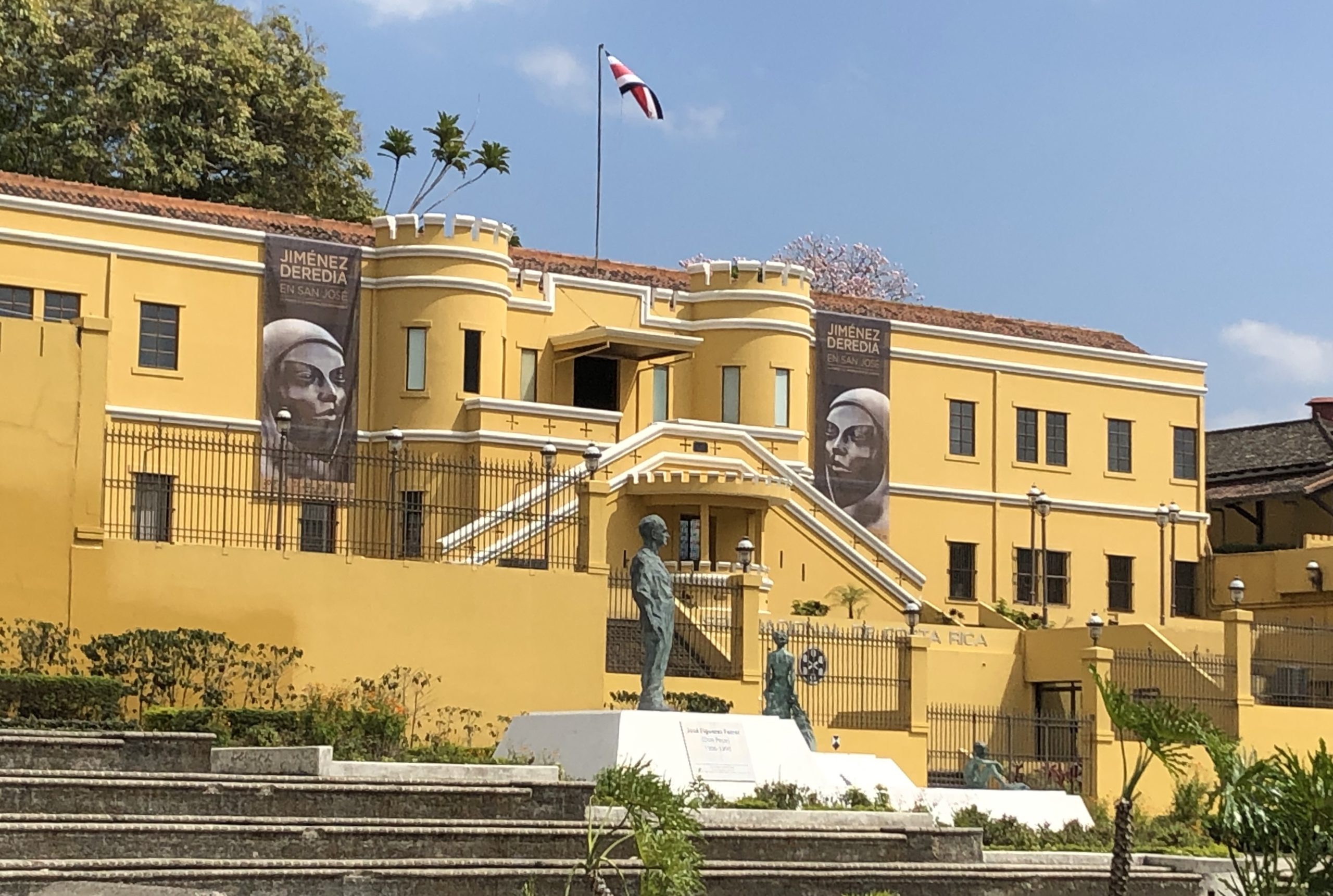
I ended with this question: Who are the civic media storytellers and innovators that inform and inspire you? How do you (or how might you) incorporate digital and civic media storytelling into your work?
One answer would arrive after I returned to Boulder. There, I received an email from Irma Verhoevan, a workshop participant. Irma serves as Programme and Partnership Development Manager for the Earth Charter Center for Education for Sustainable Development. She and her team are currently in the design stage of a project that will collect and curate short digital narratives that showcase how people around the world imbue their daily lives and work with ethical principles and values of the Earth Charter.
After my workshop concluded, Charles Skinner, who directs the Center for Practicing Peace,offered to give me a tour of campus. I was delighted to experience the campus on foot from its center to its periphery, taking a short hike to the nature preserve and peace garden, past commemorative statues, a newly constructed open-air classroom for yoga and movement to a classroom where we met a group of children— “history in the making”—playing, singing, and telling stories.
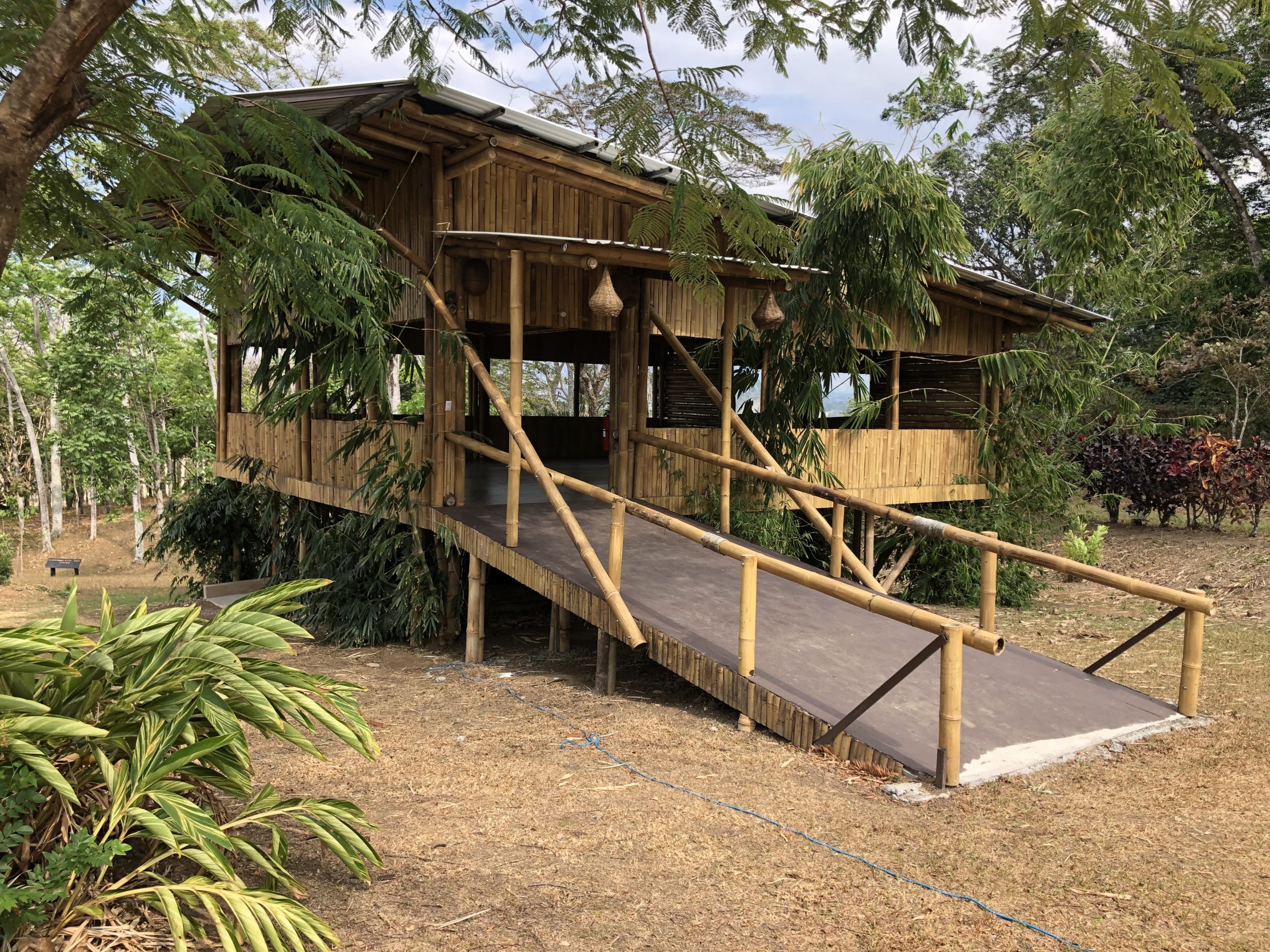
Returning to the library with Charles, I again thought of Elise Boulding. A passionate and highly adept networker-weaver of people across organizational silos and national borders, I think Boulding would have embraced the emerging field of civic media storytelling (also known as participatory civic media). While digital storytelling is relatively new, civic, community, and citizen-based storytelling has many historical antecedents: African American newspapers have communicated the values and visions of black-led Freedom movements while alternative presses, publications, and bookstores contributed widely to feminist consciousness-raising and organizing in the era of print-based media.
UPEACE has set a goal to reduce its current electrical consumption by 70 percent and as our walk drew to a close, Charles pointed to several humongous cardboard boxes that had been discarded by workers installing solar panels earlier in the day. An avid and inventive recycler, Charles saw potential in the discards, stacking them neatly by the side of the building until he could take them home to build a dollhouse for a next door neighbor. (A few weeks later, I learned that both the work on their solar-powered roof and the dollhouse had been completed.)
At the end of the day, I boarded a crowded bus that travels between the university and Ciudad Colón, carrying students, staff and faculty down a bumpy and winding mountainous road, past a Starbucks coffee plantation and dozens of electrifying yellow Cortez Amarillo trees in full blossom. I found an empty seat next to Greshma P. Raju, a student from Kerala, India, who had attended my presentation.
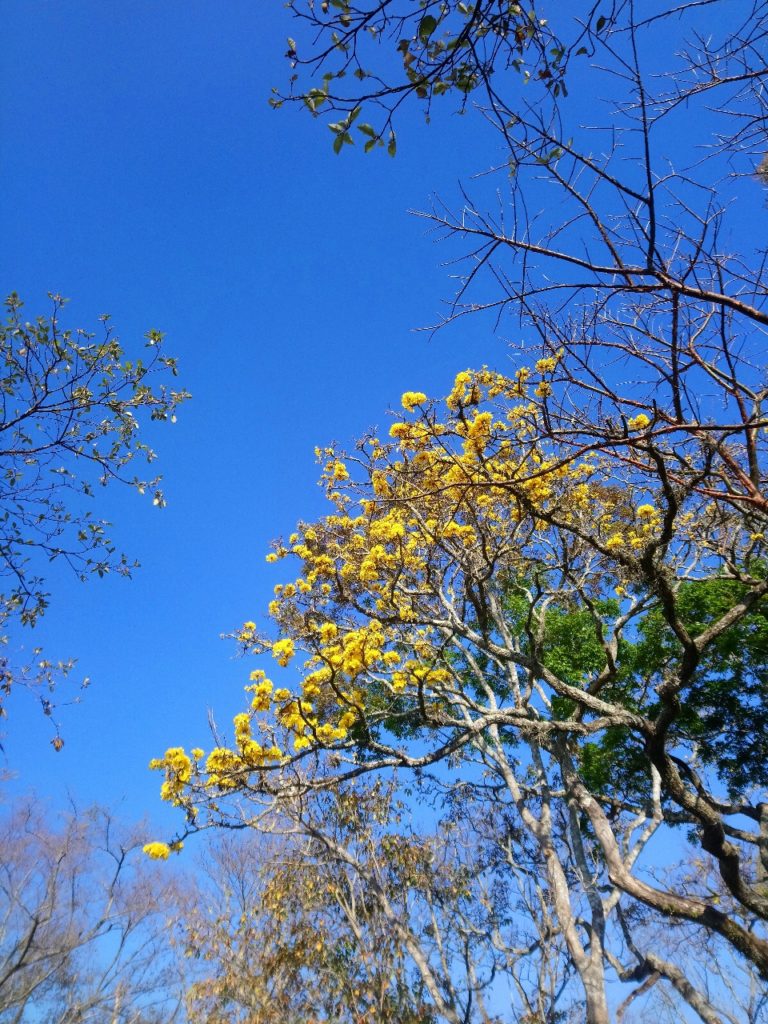
Greshma will graduate from UPEACE with an MA in International Peace Studies in June, shortly after her twenty-fourth birthday. Fluent in Malayalam and English, she is living with a Spanish-speaking family in Ciudad Colón.
When I asked about the role of her homestay in her UPEACE experience, Greshma lit up. “It’s home far away from my home. I am very much connected to all family members, including the grandparents who remind me of my grandparents.”
“Initially I used Google translator for conversation. Now they are teaching me Spanish, speaking slowly and using gestures to help me understand. While they are teaching me about Costa Rican history and the Pura Vida lifestyle; I share about Indian culture, food, language, and art.”
Post-graduation, Greshma will seek a position with a United Nations peacekeeping team. As I listened to her talk, I could not help but think of Elise Boulding’s emphasis on the role of families in building and sustaining cultures of peace, and how Greshma may likely incorporate the knowledge, skills, and mindsets she is learning from living with a Costa Rican family into her work.
Returning home inspired and nourished by a vision of how my own species might become more wise and caring, I turn my attention to preparing to teach new courses in the fall. As I work, I feel a deep sense of gratitude for so much: historic and contemporary peacebuilders, visionary conservationists, storytellers, former and current students, home-stay families, local guides with telescopes and intimate knowledge of bird habitat, wild avocado trees, and—the majestic presence of the Resplendent Quetzals.
